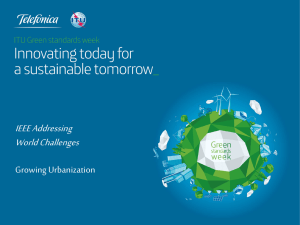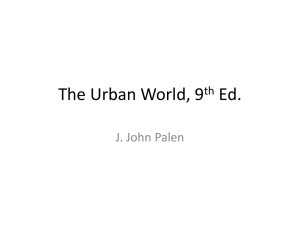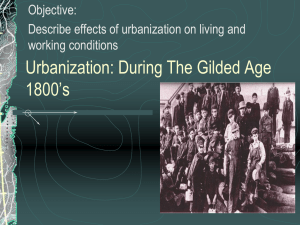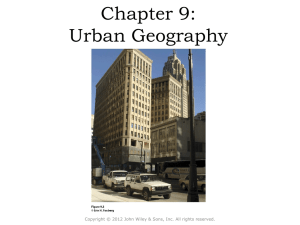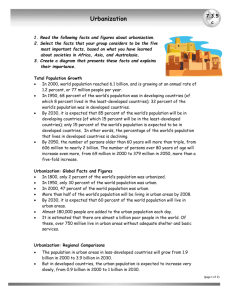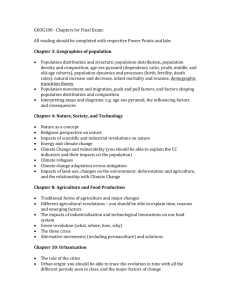The Age of Urbanisation_
advertisement
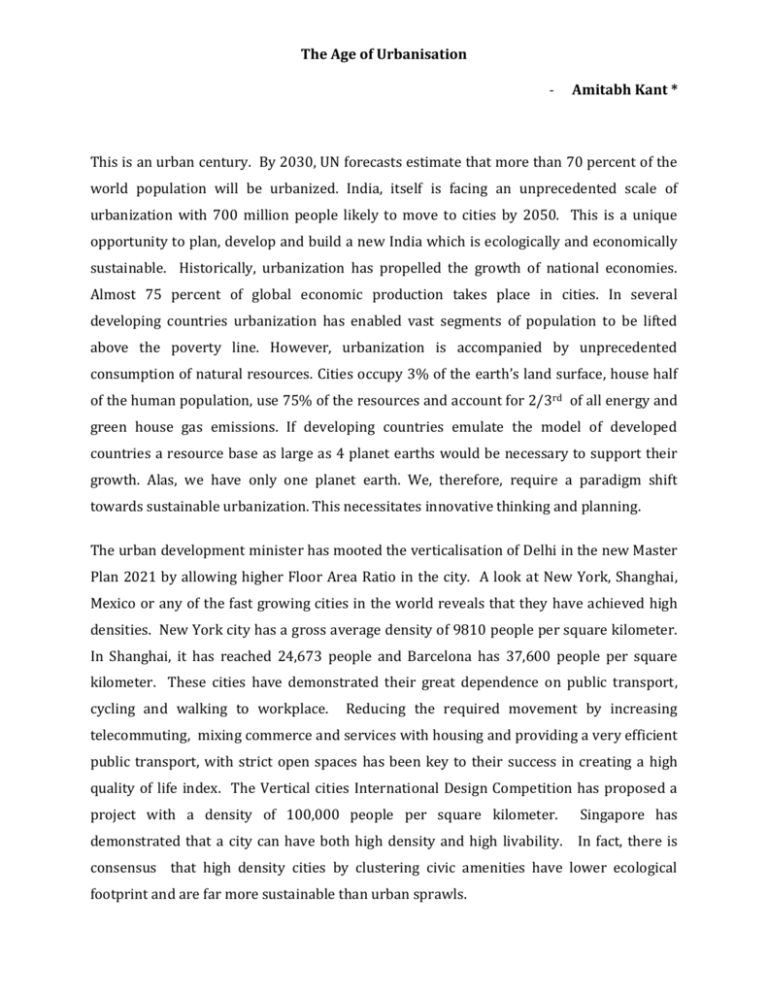
The Age of Urbanisation - Amitabh Kant * This is an urban century. By 2030, UN forecasts estimate that more than 70 percent of the world population will be urbanized. India, itself is facing an unprecedented scale of urbanization with 700 million people likely to move to cities by 2050. This is a unique opportunity to plan, develop and build a new India which is ecologically and economically sustainable. Historically, urbanization has propelled the growth of national economies. Almost 75 percent of global economic production takes place in cities. In several developing countries urbanization has enabled vast segments of population to be lifted above the poverty line. However, urbanization is accompanied by unprecedented consumption of natural resources. Cities occupy 3% of the earth’s land surface, house half of the human population, use 75% of the resources and account for 2/3rd of all energy and green house gas emissions. If developing countries emulate the model of developed countries a resource base as large as 4 planet earths would be necessary to support their growth. Alas, we have only one planet earth. We, therefore, require a paradigm shift towards sustainable urbanization. This necessitates innovative thinking and planning. The urban development minister has mooted the verticalisation of Delhi in the new Master Plan 2021 by allowing higher Floor Area Ratio in the city. A look at New York, Shanghai, Mexico or any of the fast growing cities in the world reveals that they have achieved high densities. New York city has a gross average density of 9810 people per square kilometer. In Shanghai, it has reached 24,673 people and Barcelona has 37,600 people per square kilometer. These cities have demonstrated their great dependence on public transport, cycling and walking to workplace. Reducing the required movement by increasing telecommuting, mixing commerce and services with housing and providing a very efficient public transport, with strict open spaces has been key to their success in creating a high quality of life index. The Vertical cities International Design Competition has proposed a project with a density of 100,000 people per square kilometer. Singapore has demonstrated that a city can have both high density and high livability. In fact, there is consensus that high density cities by clustering civic amenities have lower ecological footprint and are far more sustainable than urban sprawls. The standard practice in all cities across the world with limited land availability has been to raise permitted FSI over time to accommodate urban growth. In sharp contrast, Indian city administrators have consciously discouraged high density. For instance in an attempt to control migration the FSI in Mumbai was successively brought down from 4.5 to 1.33. People nevertheless continued to seek economic opportunities in Mumbai. This led to density being achieved through slums and unauthorized construction with almost 54% people living in slums and another quarter in degraded apartments. The current master planning and designing of cities in India is based on models of 19th century when land, gas and water were available in abundant quantities. Europe and America therefore created sprawling cities with vertical supply – oriented public utilities for water and power. The urbanization process was designed for cars and not people. Today’s world is a far more crowded and complex with severe resource constraints. Digital technology has enabled us to cut across utilities and create smart, intelligent and ubiquitous cities with real time governance and control. To accommodate the vast segment of population moving from rural to urban areas in the 21st Century, China is building the equivalent of three Americas, India will have to create five Americas and Indonesia two Americas. This is a daunting task. In case the strategic choices are not correct we will be constantly building and demolishing causing severe deterioration of resources. Therefore the urban approaches chosen and the infrastructure decisions made will have severe consequences for generations to come. This is both a challenge and a unique opportunity. India has been an extremely reluctant urbanizer. Though it is a late starter, it has significant advantages to reap, if it can use technology to leapfrog stages of development. Across the world, cities are using technologies to become smarter. Songdo’s wired city initiative in Korea, Singapore’s e-Symphony transport system and Galway’s Smart Bay advanced water management system are all examples of the revolutionary shift that is taking place. Cities are managing key functions horizontally – city services, transport, communications, water, smart grids, public safety, education and health all through a digitally managed central command room. Confronted by a severe natural calamity, Rio de Janerio integrated information and processes from over 30 different agencies to provide information to its citizen on civic services and emergencies. The ubiquitous city of Songdo gives citizens and businesses a range of new services from automated waste and water recycling to universal smart cards and accessing medical records. Smart Technology is enabling Stockholm to reduce inner city traffic by 25 percent and emission by 14 percent. A new public safety system in Chicago allows real time video surveillance and faster response to emergencies. These are examples of cities using technology for Smart development in a fast urbanizing world. How India manages its urbanization in the coming decades will determine its future. This requires political leadership, vision, capacity building and institutional reforms. ***** * The author is CEO & MD, Delhi – Mumbai Industrial Corridor Development Corporation. The views expressed are personal.
